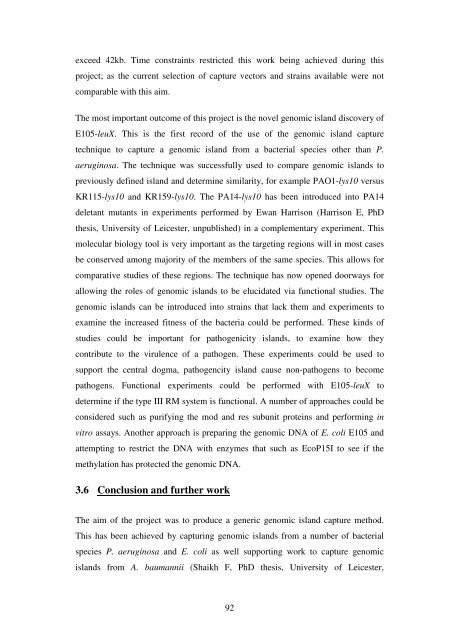5 The role of quorum-sensing in the virulence of Pseudomonas ...
5 The role of quorum-sensing in the virulence of Pseudomonas ...
5 The role of quorum-sensing in the virulence of Pseudomonas ...
You also want an ePaper? Increase the reach of your titles
YUMPU automatically turns print PDFs into web optimized ePapers that Google loves.
exceed 42kb. Time constra<strong>in</strong>ts restricted this work be<strong>in</strong>g achieved dur<strong>in</strong>g this<br />
project; as <strong>the</strong> current selection <strong>of</strong> capture vectors and stra<strong>in</strong>s available were not<br />
comparable with this aim.<br />
<strong>The</strong> most important outcome <strong>of</strong> this project is <strong>the</strong> novel genomic island discovery <strong>of</strong><br />
E105-leuX. This is <strong>the</strong> first record <strong>of</strong> <strong>the</strong> use <strong>of</strong> <strong>the</strong> genomic island capture<br />
technique to capture a genomic island from a bacterial species o<strong>the</strong>r than P.<br />
aerug<strong>in</strong>osa. <strong>The</strong> technique was successfully used to compare genomic islands to<br />
previously def<strong>in</strong>ed island and determ<strong>in</strong>e similarity, for example PAO1-lys10 versus<br />
KR115-lys10 and KR159-lys10. <strong>The</strong> PA14-lys10 has been <strong>in</strong>troduced <strong>in</strong>to PA14<br />
deletant mutants <strong>in</strong> experiments performed by Ewan Harrison (Harrison E, PhD<br />
<strong>the</strong>sis, University <strong>of</strong> Leicester, unpublished) <strong>in</strong> a complementary experiment. This<br />
molecular biology tool is very important as <strong>the</strong> target<strong>in</strong>g regions will <strong>in</strong> most cases<br />
be conserved among majority <strong>of</strong> <strong>the</strong> members <strong>of</strong> <strong>the</strong> same species. This allows for<br />
comparative studies <strong>of</strong> <strong>the</strong>se regions. <strong>The</strong> technique has now opened doorways for<br />
allow<strong>in</strong>g <strong>the</strong> <strong>role</strong>s <strong>of</strong> genomic islands to be elucidated via functional studies. <strong>The</strong><br />
genomic islands can be <strong>in</strong>troduced <strong>in</strong>to stra<strong>in</strong>s that lack <strong>the</strong>m and experiments to<br />
exam<strong>in</strong>e <strong>the</strong> <strong>in</strong>creased fitness <strong>of</strong> <strong>the</strong> bacteria could be performed. <strong>The</strong>se k<strong>in</strong>ds <strong>of</strong><br />
studies could be important for pathogenicity islands, to exam<strong>in</strong>e how <strong>the</strong>y<br />
contribute to <strong>the</strong> <strong>virulence</strong> <strong>of</strong> a pathogen. <strong>The</strong>se experiments could be used to<br />
support <strong>the</strong> central dogma, pathogencity island cause non-pathogens to become<br />
pathogens. Functional experiments could be performed with E105-leuX to<br />
determ<strong>in</strong>e if <strong>the</strong> type III RM system is functional. A number <strong>of</strong> approaches could be<br />
considered such as purify<strong>in</strong>g <strong>the</strong> mod and res subunit prote<strong>in</strong>s and perform<strong>in</strong>g <strong>in</strong><br />
vitro assays. Ano<strong>the</strong>r approach is prepar<strong>in</strong>g <strong>the</strong> genomic DNA <strong>of</strong> E. coli E105 and<br />
attempt<strong>in</strong>g to restrict <strong>the</strong> DNA with enzymes that such as EcoP15I to see if <strong>the</strong><br />
methylation has protected <strong>the</strong> genomic DNA.<br />
3.6 Conclusion and fur<strong>the</strong>r work<br />
<strong>The</strong> aim <strong>of</strong> <strong>the</strong> project was to produce a generic genomic island capture method.<br />
This has been achieved by captur<strong>in</strong>g genomic islands from a number <strong>of</strong> bacterial<br />
species P. aerug<strong>in</strong>osa and E. coli as well support<strong>in</strong>g work to capture genomic<br />
islands from A. baumannii (Shaikh F, PhD <strong>the</strong>sis, University <strong>of</strong> Leicester,<br />
92














